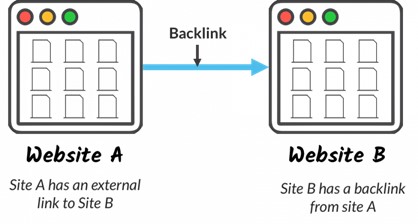Do conversations with your SEO expert about your site’s performance leave you with more questions than answers? You’re not alone. The vast number of SEO considerations can be overwhelming, and arcane jargon is super-abundant in the world of search engine optimization.
Let’s simplify and communicate in plain English. It all comes down to what Google considers important SEO ranking factors. If you understand them, you can improve your Google ranking. Let’s focus on the top 13.
Top Search Engine Ranking Factors
1. Backlinks
Another site links to yours. That’s a backlink. Think of it as a popularity vote. Backlinks from relevant sites tell Google your content is reliable, trustworthy, and authoritative. That makes them extremely valuable to your overall SEO.

Source: Moz, “Backlinks”, 2020
High numbers of authoritative backlinks raise your site’s authority in Google’s eyes. Develop a link-building strategy to increase your domain’s authority.
2. High-Quality Content
Content is king, but only if it’s good stuff. Investment in your site’s content is crucial to SEO. Create factual, helpful, and thus valuable content. Google pays a lot of attention to it. Develop a content strategy that will attract users. Google interprets a lack of traffic as a sign that your site does not help searchers.
3. Optimized Content
Once you’ve worked hard to build high-quality content, optimize it. Seed it with popular search keywords, so users can find you. When users click on your site and stay on it, Google sees that users find your content helpful. This means your ranking can increase.
4. Page Load Speed
Users don’t like to wait. Pages with longer loading times have higher bounce rates. These items slow page loading:
- Unoptimized images
- JavaScript issues
- Too much flash content
- HTTP requests
- Unused code
- Bad hosting service
- Issues with CMS plugins
- Server location
Make sure that your site’s page speed is ideal. Pages that take longer to load can cause serious harm to your site’s overall performance, notably in website traffic and conversion rates.
5. Mobile-First Indexing
Google recommends creating a site with mobile-first indexing, which means Google uses the mobile version of the content for indexing as well as ranking. The mobile version of your site is the starting point that Google will use in its index. However, don’t forget about desktop usability. It’s not mobile-only indexing.
A mobile-friendly site builds credibility and greatly improves user experience. Google prizes user experience. Websites that deliver good mobile experience generally rank better.
6. Site Security
Website security is a top priority. Users need to see that your site is trustworthy. You should have security plugins, very strong passwords, and provide frequent updates. A URL beginning with https:// instead of http:// is crucial. HTTPS is a ranking signal. An unsecured website puts users at risk and could hinder SEO.
Poor security puts you at risk of hacker attacks. A secured site will protect your customer’s information and any third-party integrations.
7. Crawlability
Google describes crawlability: “Crawlers look at webpages and follow links on those pages, much like you would if you were browsing content on the web. They go from link to link and bring data about those webpages back to Google’s servers.”
Your site should be hospitable to crawlers. You want search engines to be able to access and crawl content on your pages. Broken links can hinder search engines’ ability to crawl a web page. If Google cannot reach your content, Google cannot raise your ranking.
8. User Intent
Great content satisfies user intent, which comes in three types:
- Navigational - The searcher wants to go to a certain site
- Informational - The searcher seeks information
- Transactional - The searcher is ready to buy
Take a deep look into the users who would want to get to your site (even if those users are not aware of your site when they type in their queries). Once you have a clearer picture of your users and user behavior, you can tailor content that adds value for those target users. That makes you a hero to Google, whose top goal is satisfying searchers.
9. HTML Tags
HTML tags tell Google what parts of your content are most important. These include meta descriptions and title tags, which users see on search results pages. Therefore, descriptions and titles should have specific keywords. Below is an example of how these HTML tags look on the search engine results page.
 Heading tags, also, are important HTML tags. They attach to the headings and subheadings that divide your copy into sections, establish a hierarchy of content elements, and help Google crawlers “understand” what your article is about. For best SEO practice avoid using multiple H1 tags. Multiple H2s, H3s, etc., on the other hand, are fine, as they help break up the content on your web page.
Heading tags, also, are important HTML tags. They attach to the headings and subheadings that divide your copy into sections, establish a hierarchy of content elements, and help Google crawlers “understand” what your article is about. For best SEO practice avoid using multiple H1 tags. Multiple H2s, H3s, etc., on the other hand, are fine, as they help break up the content on your web page.
Alt text, or alternative text, is another important HTML tag. It describes images to search engines and allows your images to appear in image-search results. Alt text also reads aloud descriptions of the images for the benefit of visually impaired users.
10. Sitemap
Sitemaps help search engines index your pages and they raise your site’s visibility. By submitting an XML sitemap into Google Search Console, you tell Google that your web pages are high-quality search landing pages.
Submit an XML sitemap after publishing or updating your website. This will ensure that search engines have the most updated version. An XML sitemap is good SEO practice -- vital for bringing in traffic.
11. User Experience
Google’s priority is the user. If Google believes your site will not benefit the user, your site will not rank well. Always think of the user while creating content and designing your site’s navigation.
Understand your target audience and give them content they want and need. Almost every algorithm update Google has rolled out – and will roll out in the future – has focused on the user. So, an intuitive, user-friendly website is increasingly important for SEO.
12. Friendly URL Structure
Your URL should make sense to the user. Keep the URL short and easy to understand. A well-organized URL structure makes it easy for users to know where they are on your site.
Friendly URL structure plays a big role in social media distribution of your content. Long, confusing URLs look bad when your users share them on Facebook, Twitter and other social media. They also look bad in emails. And long, non-descriptive URLs do not help users remember your site or your business.
13. Avoid Duplicate Content
Duplicate content pushes down ranking and traffic and degrades user experience both on-site and in search.
Search engines try to avoid showing duplicate content on the search engine results page. A search engine that encounters duplicate content must choose and rank the one most likely to be the best search query result. Don’t leave that decision to the search engine.
Conclusion
Don’t get lost in the thicket of SEO details. Remember the two golden rules: Create great content and always put the user first.
To keep up with the latest digital marketing trends, subscribe to our blog emails. SEO is always changing, and we are here to guide you through it. If you need assistance or answers to questions, don’t hesitate to contact us.






